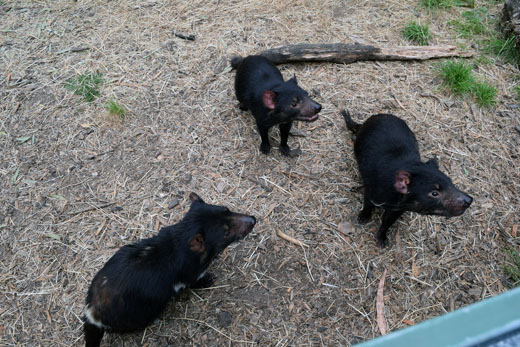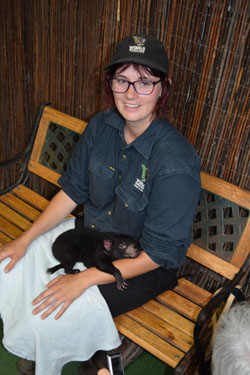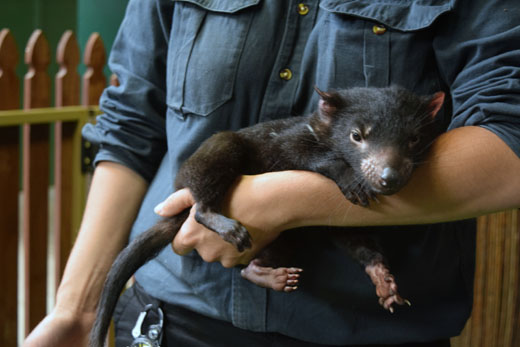
Editor’s Note: This is the ninth in a series of stories researched during Don and Nancy Harrison’s 50th Wedding Anniversary cruise from Sydney, Australia, to San Diego. Previous installments of the series, which runs every Thursday, may be found by tapping the number of the installment: 1, 2, 3, 4, 5, 6, 7, 8
By Donald H. Harrison


GUNNS PLAINS, Tasmania, Australia – Nancy and I arranged to be taken from the Port of Burnie to the village of Gunns Plains, Tasmania, because we wanted to get the lowdown on a favorite cartoon character given a voice by the Jewish “Man of 1,000 Voices,” Mel Blanc. I’m speaking, of course, of “Tazzy,” the Tasmanian Devil.
Those of you who never saw him in a Warner Brothers cartoon missed a treat. Tazzy whirled around like a dervish, eating everything in his sight, and could only be deterred from his growling and chomping by one thing: music. Then, the cartoon character would turn into a pacific, tune-struck sweetie—a total 180 degree turn in character.
In his memoir That’s Not All Folks, Blanc said dreaming up a voice for Tazzy was a challenge. “Because of his ravenous appetite, it seemed to me that he should growl slobbering, indecipherable gibberish. I demonstrated it for the director and said, ‘I defy you or anybody else to tell me he doesn’t sound like a Tasmanian Devil!’”
What better place than here in Tasmania to learn what a Tasmanian Devil really sound like, and why in the devil it’s called a “devil” in the first place?
En route, Ian Jones, a vice president of the Burnie Chamber of Commerce, suggested that Blanc was pretty well on target. “They hiss and they fart and they snarl; they sound like relatives at a holiday dinner,” Jones said.

Nicole Mason says Tasmanian Devil pups are “cute.”At Wings Wildlife Park, Nicole Mason, an animal keeper who sometimes raises in her home the Tasmanian Devil pups that are aged between eight months and a year, had a somewhat kinder description: “They have a loud rrrowwwrrrr, but it starts off soft, and then gets loud, and they hiss at each other and give a very loud growl when they are feeding,” she said.
“They are cute,” she declared with a smile.
The reason that they are called devils is because “when they are growling, all the little veins rise to the surface of the ear, and thee blood rushes to the surface, so you get those red ears, glowing eyes, and sharp white teeth,” Mason explained.
In the past, farmers did not know what role Tasmanian Devils played in the ecology. The farmers might have seen the devils feeding on a farm animal’s carcass and assumed that the devils killed the animal. But, that rarely would have been the case, Mason said. Tasmanian Devils are scavengers which eat carrion and carcasses, but usually are not the actual killers. If small farm animals died from something other than natural causes, the culprit might have been a quoll, a marsupial that sometimes is called the “native cat” because of a similarity in appearance. When it’s eaten its full, the quoll will walk away from its kill and Tasmanian Devils, animals with the equivalent of a 3,000-pound bite that can crunch through fur and bones, move in to finish off the dinner. Facilitating the Tasmanian Devil’s task is a mouth that will open to a 90-degree angle, all the better to crunch with.
Mason told us that a Tasmanian Devil can pick up the smell of a dead animal from as far away as 15 to 20 kilometers—somewhat akin to a shark being able to detect a single drop of blood in the water from a great distance away. Although Tasmanian Devils typically are solitary creatures, as many as five of them will descend on an animal carcass, and then fight and bite each other as they jockey for better feeding position.
The tragedy of this kind of feeding is that a cancer known as facial tumor disease has been spreading among the Tasmanian Devil population, transmitted through biting. It is estimated that the disease has caused the deaths of 80 to 90 percent of the Tasmanian Devil population, leading to public and private zoos doubling their conservation efforts. Recently, in fact, a male and female Tasmanian Devil, both disease free, were sent to the San Diego Zoo in my hometown by the Taronga Western Plains Zoo in mainland Australia as part of the international conservation drive.
Mason says the tumor starts when a Tasmanian Devil is bit by another animal carrying the disease, then grows so large on the devil’s face that it cannot open its mouth to eat. Usually the devil dies within eight months to a year after such contact. As devils feed together, one infected devil can infect four or five others per feeding, and they in turn can do the same.
The Tasmanian government has asked everyone who sees a dead Tasmanian devil to report its whereabouts to authorities, so that it can be tested for the disease. Often dead devils can be found on roadways, not because of the disease, but because they were so busy feeding on carrion, they didn’t see cars coming toward them.
Mason told us the only time devils will eat a live animals is when it is wounded, injured, or very sick. Otherwise, it sticks to its ecological assignment as a scavenger.

Tasmanian Devils come by their combativeness with each other quite naturally, said Mason. When a mother Tasmanian Devil gives birth to her young, typically there will be a litter numbering between 25 to 50. The newborns, said Mason, “are very underdeveloped, perhaps the size of a grain of rice when they make their way into the pouch, but it is only the strongest four that make it into the pouch and latch onto a teat that are able to survive.” Once the mother knows that the four have latched on, “she eats her remaining young” so only the strongest survive.
The babies remain in the pouch for approximately four and a half months, before coming out to explore the den. Approximately at six months, the mother will start weaning her young. She will bring back to the den food, meat, and water, or “take them with her and show them how to survive in the wild.” At seven to eight months, she will leave her babies to fend for themselves.
That’s where Mason’s home-care comes in. She takes home those Tasmanian Devil babies that seem too frail to survive and bottle feeds them, up about until the time they are one year old, or they let Mason know they don’t want to be held and fed.
She said that Wing’s Animal Park has approximately 20 Tasmanian Devils on site. During breeding season, Wing’s animal keepers will put one male into a pen with two females. “Males are very lucky here because in the wild they would have to compete with three or maybe four devils before they could mate with a female,” she said.
In the wild, the male will leave the female and look for another female to mate with – that dirty devil! This makes it difficult to trace a Tasmanian Devil’s genealogy in the wild. But at Wing’s Animal Park, which male impregnated which female is carefully recorded, so that brothers and sisters are not inadvertently mated with each other.
Although one can see the Tasmanian Devils in their pens during the day; this would not be so easy in the wild. The devils are nocturnal animals, which prefer to remain in their dens, or inside hollow logs, during the day.
In preparing pens for the animals, Mason says she makes certain that they have the same kind of surroundings as they would in the wild, and “we try to make it as natural as possible.” They are fed a diet of wallabies and possums brought in from the wild by licensed hunters. Live animals in the park should never have to fear being fed to other species; those that are brought to Wing’s Animal Park stay safe in the park.
Having studied and cared for Tasmanian Devils through their entire life cycle, Mason says that “they all have their own personalities, their own characteristics. Some devils love being handled; they can be handled up to two years of age, and some devils get to be eight months and they don’t want to be handled. They let you know.”
When it was time to leave, I wondered whether there were any essential questions about Tasmanian Devils I had failed to ask. But, no, I decided; in the words of Mel Blanc, “That’s all folks!”
*
Harrison is editor of San Diego Jewish World. He may be contacted via donald.harrison@sdjewishworld.com
Pingback: A little bit of Indonesia aboard Dutch ship | San Diego Jewish World